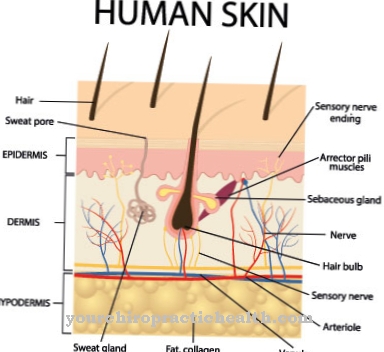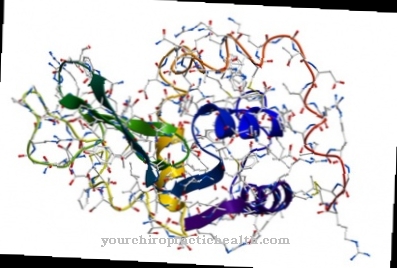The Spheroidal cell anemia is a genetic disease with the main symptom anemia. The anemia is due to the reduced lifespan of red blood cells due to defects in the erythrocyte membrane. Therapy consists of removing the spleen.
What is spheroidal cell anemia?

© Double Brain - stock.adobe.com
Hemolytic anemia is a type of anemia in which the life of the red blood cells is greatly reduced. Hemolytic anemia is also that Ball cell anemia. The disease will too hereditary spherocytosis called and is therefore a genetic anemia, which is based on a structural defect in the erythrocytes.
This form of anemia is the most common anemic disease in Central Europe. The prevalence is given as one affected person below 2000 and is accordingly high. According to experts, the number of unreported cases of the disease is probably much higher. In most cases, ball cell anemia is inherited. In some cases, however, it also corresponds to a sporadic new mutation of certain genes.
Sickle cell anemia, which is a hemoglobinopathy and is caused by the formation of abnormal hemoglobin, must be distinguished from spherical cell anemia. Like sickle cell anemia, spherical cell anemia is a corpuscular hemolytic anemia. These forms of anemia are primarily based on genetic defects in one of the erythrocyte components. In spherical cell anemia, the defect is in the spectrin or ankyrin of the cytoskeleton.
causes
There is an autosomal recessive and an autosomal dominant form of spheroidal cell anemia. In autosomal recessive inheritance, the causal defect relates to the membrane protein spectrin. In the autosomal dominant mode of inheritance, however, the defect lies in the membrane protein ankyrin.The proteins mentioned are among the main components of the erythrocytes and accordingly participate in the structure of the cytoskeleton, where they in particular regulate permeability.
Due to the hereditary membrane defect, the red blood cells lose their originally intended shape. Its flat, biconcave shape becomes a spherical shape with low surface tension. This reduces the deformability of the microspherocytes, which is a crucial component of blood viscosity. The defects in the membrane also cause increased membrane permeability. This results in an increased conversion of glycolysis and ATP.
As a result of the changes, the life of the microspherocytes is significantly reduced, as they succumb to increased phagocytosis within the spleen. The most common form of spheroidal cell anemia is caused by a genetic mutation on chromosome 8, which occurs either as part of heredity or as a new mutation.
Symptoms, ailments & signs
Globular cell anemia is made up of a number of clinically characteristic symptoms. The spherocytes are already metabolically damaged when they pass through the spleen. This leads to a partial or holistic lysis of the cells. The patient's spleen is usually severely swollen. The picture corresponds to a splenomegaly. Bilirubin accumulates as the cells pass through the liver.
When the blood cells are broken down, the excretory system is overloaded and jaundice develops. The more severe the disease, the higher the anemia and the accompanying jaundice. Often the patients also suffer from gallstones, as there is an excess of bile pigment. Iron is increasingly converted as part of the erythrocyte breakdown and can subsequently lead to the storage of iron in the liver, which is often associated with a cirrhotic remodeling of the tissue.
Patients' anemia is typically associated with fatigue, exhaustion, poor performance and paleness or headaches. In addition, dyspnoea, difficulty concentrating or strong palpitations can occur. With an early onset of the disease, mental and physical developmental disorders can also set in.
Hemolytic crises in the context of certain infections can be life-threatening for patients with globular cell anemia, as the replication of erythrocytes in the bone marrow is greatly reduced. Hemolytic crises manifest themselves primarily in fever, chills, circulatory collapse and pain.
Diagnosis & course of disease
The doctor diagnoses spherical cell anemia with the help of medical laboratory tests. The blood count shows normochromic anemia and signs of hemolysis such as hyperbilirubinemia or decreased haptoglobin and increased LDH values. The mean corpuscular concentration of hemolobin shows an increase. In addition, light microscopic examinations of the red blood cells can take place, in which the erythrocytes do not show any central lightening due to their spherical shape.
If the doctor tests the hemolytic behavior using solutions with decreasing osmolarity, the pathological erythrocytes show a reduced osmotic resistance. The prognosis for patients with spheroidal cell anemia is relatively favorable, as promising treatment options are now available.
Complications
In most cases, spheroid cell anemia causes damage and discomfort to the spleen. The patient's spleen is clearly swollen and enlarged and is not infrequently painful. Symptoms in the liver can also lead to jaundice in the patient. Gallstones also occur, which lead to extremely severe and uncomfortable pain for the patient.
The patients feel tired and exhausted and can no longer actively participate in everyday life. The resilience of the person affected also decreases considerably due to the spheroidal cell anemia. There are also disturbances in concentration and relatively severe headaches. The heart rate is increased so that palpitations are not uncommon. Ball cell anemia can also lead to development disorders in children.
Those affected also suffer from chills and fever, which can lead to a circulatory collapse in which the patient loses consciousness. A fall could possibly result in injury. In the worst case, spheroid cell anemia leads to the failure of various organs and thus also to death. Treatment is carried out with the help of drugs. The further course of the disease depends heavily on the cause of the spheroid cell anemia.
When should you go to the doctor?
The spheroid cell anemia does not necessarily have to be treated. A specialist diagnosis and treatment is only required when a hemolytic crisis occurs. If uncharacteristic symptoms appear that indicate anemia, a doctor must be consulted within the next one to two weeks. If you experience shortness of breath, dizziness or a racing heart even during light physical exertion, it is best to consult a doctor within the same week. Ball cell anemia is a hereditary disease that progresses rapidly.
If therapy is started early, long-term mental and physical consequences can be avoided. In the absence of treatment, the disease leads to circulatory problems, developmental disorders and, in the worst case, death. Certain infections can also cause a hemolytic crisis, which can be life-threatening. That is why a doctor should be consulted if there is any suspicion. If complications arise, first aiders must call in the civil rescue service. At the same time, first aid measures must be carried out. Further treatment is carried out by the family doctor, an internist or the cardiologist, depending on the severity and form of the symptoms.
Treatment & Therapy
Globular cell anemia does not require therapeutic steps in all cases. Therapy is not absolutely necessary as long as no hemolytic crisis occurs. If the hemolytic attacks recur, a splenectomy can be performed. This procedure corresponds to a surgical procedure to remove the spleen. After a splenectomy, the average lifespan of the erythrocytes usually normalizes.
Surgical intervention to remove the spleen should not be performed on children less than six years of age. These children are at high risk for OPSI syndrome, known as a complication of splenectomy. The complication is a seriously septic clinical picture that can lead to multiple organ failure and comatose conditions and, in extreme cases, can be fatal.
The minimization of this risk of complications requires a previous vaccination against diseases such as pneumococci, Haemophilus influenzae type B and meningococci. In extreme cases, children under the age of six can still be operated on, but then only partial removal of the spleen should be sought.
Also, before removing a patient's spleen, the doctor should rule out the presence of an accessory spleen. If an accessory spleen is present and is not removed during splenectomy, the patient's clinical symptoms will persist.
Outlook & forecast
If a treatment is used, the health irregularities that have occurred are usually alleviated. Overall, the prognosis for the disease can be described as good. There are different therapeutic approaches that doctors can use depending on the individual circumstances. In addition, intensive and extensive treatment does not have to be initiated in all cases. As a result, no further medical measures are necessary for some patients with a diagnosed spheroid cell anemia. They have the opportunity to cope with everyday life with the disease without any problems.
However, the likelihood of an increase in problems and discomforts that have arisen is increased without medical supervision. Therefore, it is important for a good prognosis that the patient see a doctor regularly. This is the only way to react to changes in good time.
In particularly severe cases, the affected person's spleen is removed. If no complications arise during the surgical procedure, the patient can normally be discharged from the treatment as recovered after the wound and healing process is complete. However, surgery is usually not performed on patients under six years of age. Here the state of health only improves by taking medication. Only when it reaches the minimum age can the spleen be removed.
prevention
Globular cell anemia cannot be prevented in the narrower sense, as it is a genetic disease.
Aftercare
In most cases, those affected with spheroidal cell anemia have no or very few follow-up measures available, although in most cases these are very limited. First and foremost, a comprehensive diagnosis and treatment must be carried out so that no further complications or other complaints can occur. In some cases, there may also not be a complete healing.
Most of those affected are dependent on various surgical interventions that can alleviate the symptoms. The affected person should rest after such an operation and stay in bed. In any case, strenuous or stressful activities should be avoided in order not to unnecessarily burden the body.
Likewise, many of those affected need help and support from their own family, although psychological support is also necessary in many cases. After the spleen has been removed, the affected person should follow a healthy lifestyle with a healthy diet. A nutrition plan can also be drawn up by the doctor. In many cases, contact with other patients with globular cell anemia can also be useful, as this can lead to an exchange of information.
You can do that yourself
Patients with spheroidal cell anemia are severely restricted in their everyday life by the symptoms of the disease. Since the sick are often children, appropriate treatment of the complaints is the responsibility of the parents. Fatigue and reduced performance limit the patient's well-being and often interfere with their work or school attendance, so that urgent action is required.
Regular check-ups with a doctor are essential to monitor the course of the disease. Operational measures are not necessary in every case. Because complaints such as headaches and palpitations can sometimes be treated with medicinal substances, whereby the patients strictly follow the prescribed dosage instructions of the specialist.
Since in some cases the disease is accompanied by a haemolytic crisis, which represents an acute danger to the life of those affected, the social environment must be informed about the presence and type of the disease. This ensures that in an emergency the patient will receive adequate first aid and that he will receive emergency medical treatment quickly. In severe cases, removal of the spleen is required, with doctors removing the organ during an inpatient stay. For some time after the operation, the patients are still impaired in their physical performance and avoid strenuous physical activity.





.jpg)



.jpg)



.jpg)



.jpg)







.jpg)


